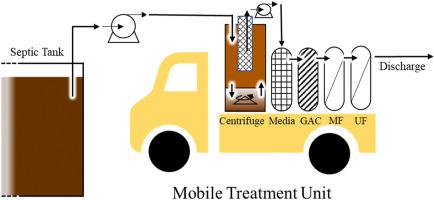Journal of Environmental Management ( IF 8.0 ) Pub Date : 2020-09-17 , DOI: 10.1016/j.jenvman.2020.111361 Aaron A Forbis-Stokes 1 , Arumugam Kalimuthu 2 , Janani Ravindran 2 , Marc A Deshusses 3

|
A mobile septage treatment unit was built in India using readily available filters and membranes (mesh fabric, sand, granular activated carbon (GAC), microfilter, ultrafilter) and installed on the bed of a small truck. The target application was emptying of septic or sewage holding tanks and concentration of suspended solids while generating a liquid that could be discharged. The system was evaluated for operational and treatment performance while processing septage in the field at 108 sites in Tamil Nadu, India. After one phase of evaluation (Phase I), the system was improved and three replicate systems with slight modifications were fabricated for a second round of evaluation (Phase II) alongside the original, but modified unit. In Phase I, 105 m3 of septage was processed at an average flow of 623 L h−1 and with high removal efficiencies: 83% chemical oxygen demand (COD), 75% total suspended solids (TSS), and 98.4% total coliform (TC). In Phase II, the original and three new systems combined treated 168 m3 of septage. One of the new systems doubled in capacity and processed septage at an average flow of 2700 L h−1 while the other three averaged 1290 L h−1. The removal efficiencies in Phase II were 80% COD, 81% TSS, and 99% TC averaged between the four systems. Pass through of soluble contaminants (e.g. soluble COD, NH3–N) remain the primary challenge for treatment performance. Success may be limited with some septage due to seasonality, location, or septage age, and further validation and optimization may be necessary. However, the septage in this study was treated to local standards, and the system offers a method of onsite treatment while reducing the need of costly and often inefficient septage emptying services. Further, the system can be produced at a cost competitive to traditional septage hauling trucks.
中文翻译:

移动式分离处理装置的技术评估和优化。
在印度,使用易于使用的过滤器和膜(网眼织物,沙子,颗粒状活性炭(GAC),微过滤器,超滤器)建造了移动式分离处理装置,并将其安装在小型卡车的床上。目标应用是排空化粪池或污水处理池,并浓缩悬浮固体,同时生成可以排放的液体。对系统进行了操作和处理性能评估,同时在印度泰米尔纳德邦的108个现场处理了隔离物。经过一个阶段的评估(第一阶段)后,系统进行了改进,并制造了三个稍作修改的复制系统,用于第二轮评估(第二阶段),与原始但已修改的单元一起进行。在第一阶段,以623 L h的平均流量处理了105 m 3的分离物-1且去除效率高:83%的化学需氧量(COD),75%的总悬浮固体(TSS)和98.4%的总大肠菌群(TC)。在第二阶段中,原始系统和三个新系统合并处理了168 m 3的分离物。一个新系统的容量和处理的分离能力增加了一倍,平均流量为2700 L h -1,而其他三个平均为1290 L h -1。在第二阶段中,这四个系统的平均去除效率分别为80%COD,81%TSS和99%TC。通过可溶性污染物(例如,可溶性COD,NH 3–N)仍然是治疗效果的主要挑战。由于季节,地点或年龄的不同,成功可能会受到一些限制,因此可能需要进一步的验证和优化。但是,本研究中的粪便已按照当地标准处理,该系统提供了一种现场处理方法,同时减少了对昂贵且通常效率低下的粪便排空服务的需求。此外,该系统的生产成本可与传统的隔离运输卡车竞争。











































 京公网安备 11010802027423号
京公网安备 11010802027423号